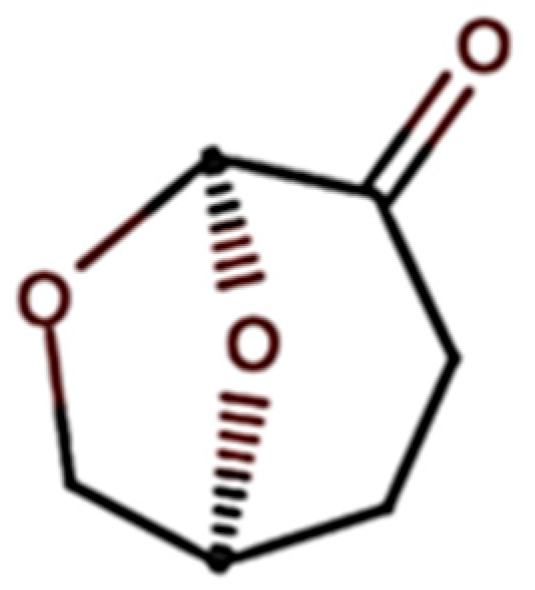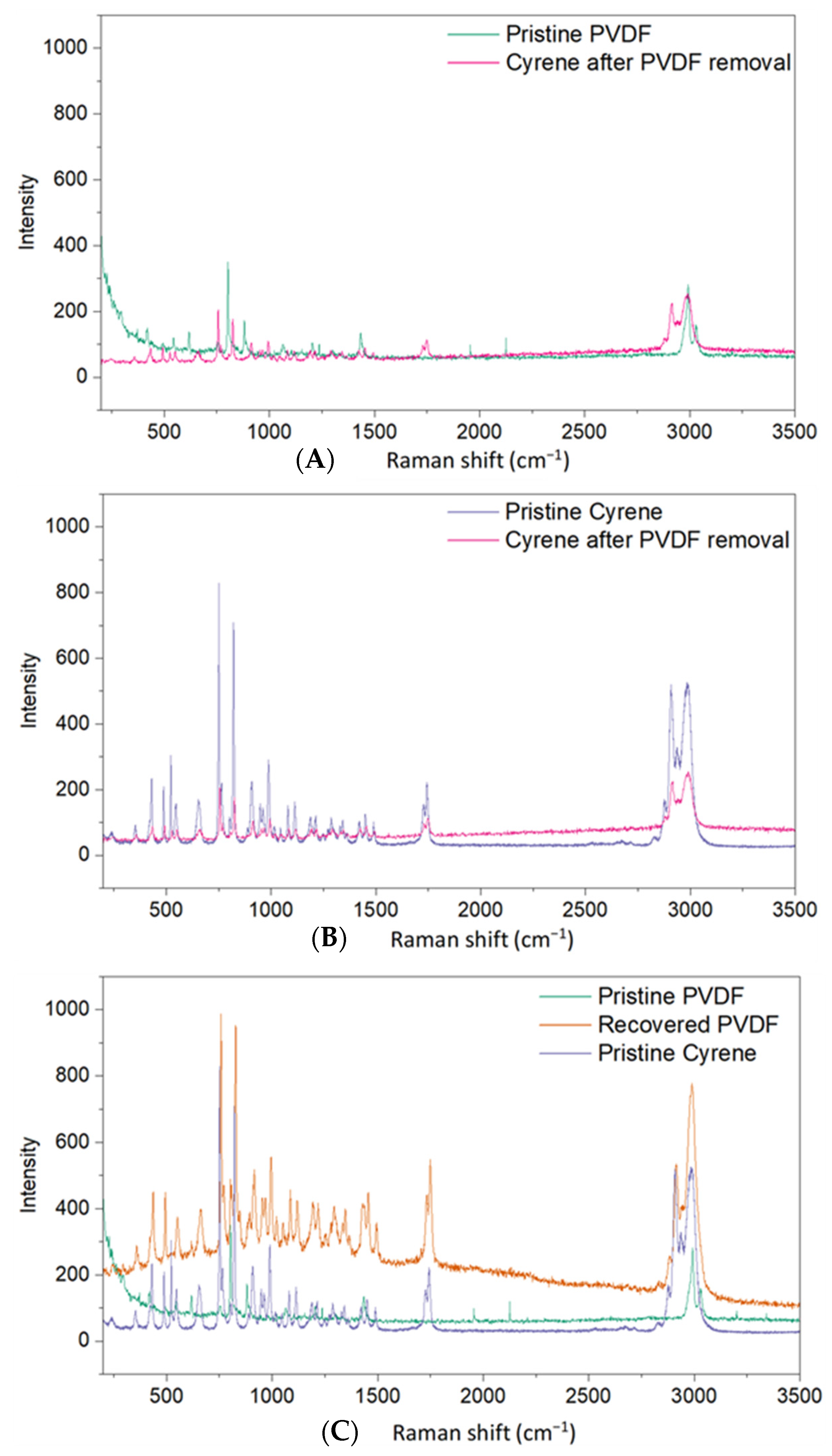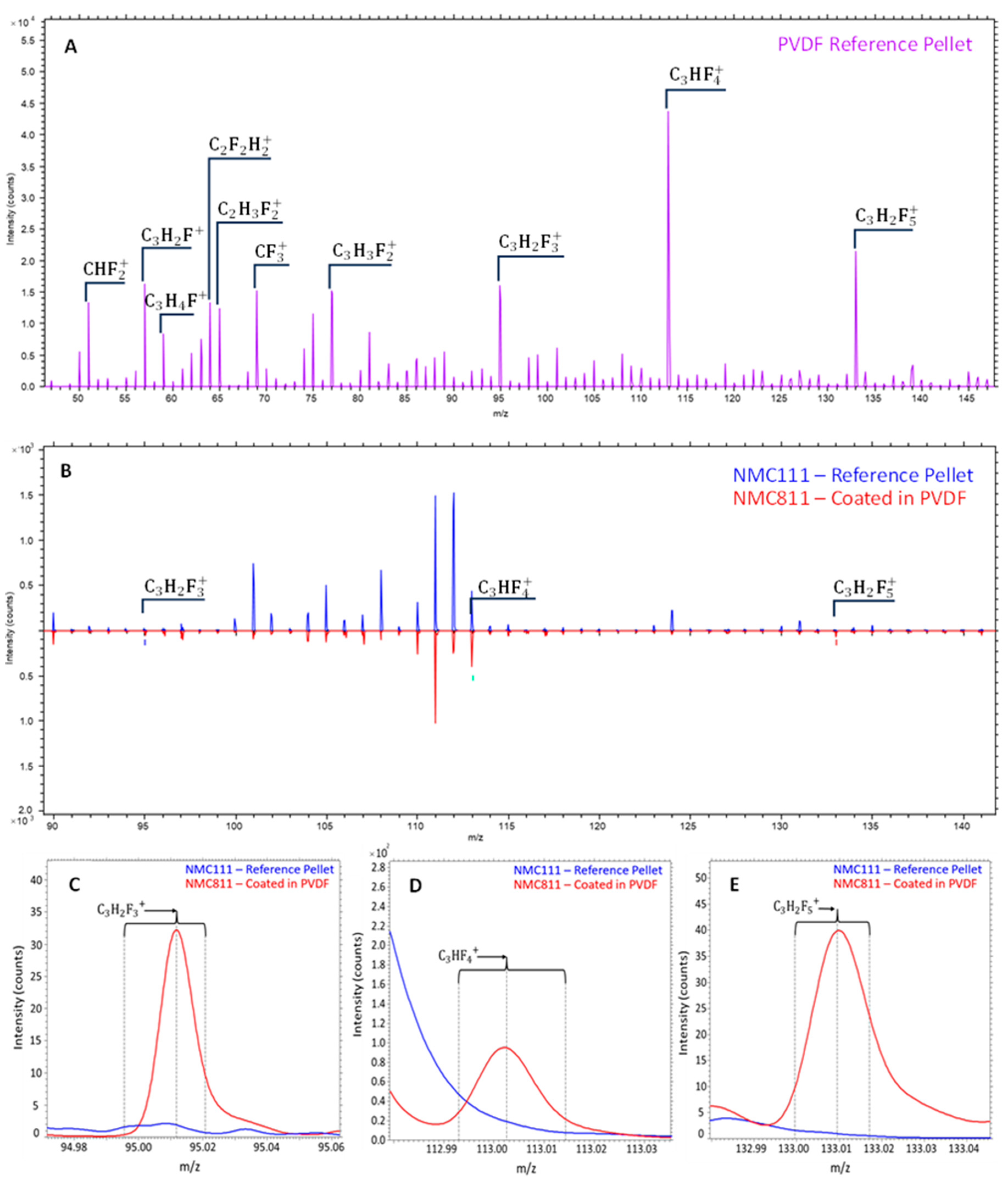Evaluation of the Removal of PVDF Using ToF-SIMS: Comparing Dihydrolevoglucosenone and Pyrolysis as Pretreatments for Cathode Materials of Lithium-Ion Batteries
Abstract
1. Introduction
2. Methods & Materials
2.1. Materials
2.2. Methods
2.2.1. PVDF Dissolution—Cyrene Pretreatment Experiments
2.2.2. PVDF Removal—Pyrolysis Pretreatment Experiments
2.3. Analytical Techniques
2.3.1. Scanning Electron Microscope (SEM)
2.3.2. Thermogravimetric Analyser (TGA)
2.3.3. Fourier-Transform Infrared Spectroscopy (FTIR)
2.3.4. Raman Spectroscopy
2.3.5. Time-of-Flight Secondary Ion Mass Spectrometry (ToF-SIMS)
3. Results and Discussion
3.1. Pure PVDF Dissolution
3.2. Cyrene Solvent Treatment
3.3. ToF-SIMS Base Spectra for Cyrene and PVDF
3.4. ToF-SIMS as a Technique for Process Evaluation
4. Conclusions
Supplementary Materials
Author Contributions
Funding
Data Availability Statement
Conflicts of Interest
References
- Ali, H.; Khan, H.A.; Pecht, M. Preprocessing of spent lithium-ion batteries for recycling: Need, methods, and trends. Renew. Sustain. Energy Rev. 2022, 168, 112809. [Google Scholar]
- Raj, T.; Chandrasekhar, K.; Kumar, A.N.; Sharma, P.; Pandey, A.; Jang, M.; Jeon, B.H.; Varjani, S.; Kim, S.H. Recycling of cathode material from spent lithium-ion batteries: Challenges and future perspectives. J. Hazard. Mater. 2022, 429, 128312. [Google Scholar]
- Arshad, F.; Li, L.; Amin, K.; Fan, E.; Manurkar, N.; Ahmad, A.; Yang, J.; Wu, F.; Chen, R. A Comprehensive Review of the Advancement in Recycling the Anode and Electrolyte from Spent Lithium Ion Batteries. ACS Sustain. Chem. Eng. 2020, 8, 13527–13554. [Google Scholar] [CrossRef]
- Mohanty, A.; Sahu, S.; Sukla, L.B.; Devi, N. Application of various processes to recycle lithium-ion batteries (LIBs): A brief review. Mater. Today Proc. 2021, 47, 1203–1212. [Google Scholar] [CrossRef]
- Pinegar, H.; Smith, Y.R. Recycling of End-of-Life Lithium Ion Batteries, Part I: Commercial Processes. J. Sustain. Metall. 2019, 5, 402–416. [Google Scholar] [CrossRef]
- Khodadadmahmoudi, G.; Tabar, K.J.; Homayouni, A.H.; Chelgani, S.C. Recycling spent lithium batteries—An overview of pretreatment flowsheet development based on metallurgical factors. Environ. Technol. Rev. 2023, 12, 2248559. [Google Scholar] [CrossRef]
- Langdon, R.; Dominish, E.; Lara, H. B-Cycle Benchmarking Program: Market Analysis & Fate Mapping, and Life Cycle Analysis; Institute for Sustainable Futures: Sydney, Australia, 2023; Available online: https://bcycle.com.au/wp-content/uploads/2023/05/Battery-MA-Report-FINAL-20230927.pdf (accessed on 12 March 2025).
- National Institute of Environmental Health Sciences. Perfluoroalkyl and Polyfluoroalkyl Substances (PFAS). 2023. Available online: https://www.niehs.nih.gov/health/topics/agents/pfc/index.cfm (accessed on 20 September 2023).
- Fenton, S.E.; Ducatman, A.; Boobis, A.; Dewitt, J.C.; Lau, C.; Ng, C.; Smith, J.S.; Roberts, S.M. Per- and Polyfluoroalkyl Substance Toxicity and Human Health Review: Current State of Knowledge and Strategies for Informing Future Research. Environ. Toxicol. Chem. 2021, 40, 606–630. [Google Scholar]
- Ehsan, M.N.; Riza, M.; Pervez, M.N.; Khyum, M.M.O.; Liang, Y.; Naddeo, V. Environmental and health impacts of PFAS: Sources, distribution and sustainable management in North Carolina (USA). Sci. Total Environ. 2023, 878, 163123. [Google Scholar]
- Scott, A.; c&en. The Battle over PFAS in Europe. Chemical and Engineering News: American Chemical Society, 18 September 2023. Available online: https://cen.acs.org/policy/chemical-regulation/battle-over-PFAS-Europe/101/i31#:~:text=The%20European%20Commission%20(EC)%20is,a%20major%20subset%20of%20PFAS (accessed on 16 October 2023).
- Kaspar, P.; Sobola, D.; Částková, K.; Knápek, A.; Burda, D.; Orudzhev, F.; Dallaev, R.; Tofel, P.; Trčka, T.; Grmela, L.; et al. Characterization of Polyvinylidene Fluoride (PVDF) Electrospun Fibers Doped by Carbon Flakes. Polymers 2020, 12, 2766. [Google Scholar] [CrossRef]
- Medeiros, K.A.R.; Rangel, E.Q.; Sant’anna, A.R.; Louzada, D.R.; Barbosa, C.R.H.; D’almeida, J.R.M. Evaluation of the electromechanical behavior of polyvinylidene fluoride used as a component of risers in the offshore oil industry. Oil Gas. Sci. Technol.-Rev. D’ifp Energ. Nouv. 2018, 73, 48. [Google Scholar]
- Versaci, D.; Nasi, R.; Zubair, U.; Amici, J.; Sgroi, M.; Dumitrescu, M.A.; Francia, C.; Bodoardo, S.; Penazzi, N. New eco-friendly low-cost binders for Li-ion anodes. J. Solid. State Electrochem. 2017, 21, 3429–3435. [Google Scholar]
- Zhong, X.; Han, J.; Chen, L.; Liu, W.; Jiao, F.; Zhu, H.; Qin, W. Binding mechanisms of PVDF in lithium-ion batteries. Appl. Surf. Sci. 2021, 553, 149564. [Google Scholar]
- Bresser, D.; Buchholz, D.; Moretti, A.; Varzi, A.; Passerini, S. Alternative binders for sustainable electrochemical energy storage—The transition to aqueous electrode processing and bio-derived polymers. Energy Environ. Sci. 2018, 11, 3096–3127. [Google Scholar] [CrossRef]
- Rensmo, A.; Savvidou, E.K.; Cousins, I.T.; Hu, X.; Schellenberger, S.; Benskin, J.P. Lithium-ion battery recycling: A source of per- and polyfluoroalkyl substances (PFAS) to the environment? Environ. Sci. Process Impacts 2023, 25, 1015–1030. [Google Scholar]
- Vanderbruggen, A.; Hayagan, N.; Bachmann, K.; Ferreira, A.; Werner, D.; Horn, D.; Peuker, U.; Serna-Guerrero, R.; Rudolph, M. Lithium-Ion Battery Recycling—Influence of Recycling Processes on Component Liberation and Flotation Separation Efficiency. ACS EST Eng. 2022, 2, 2130–2141. [Google Scholar] [CrossRef]
- Vanderbruggen, A.; Salces, A.; Ferreira, A.; Rudolph, M.; Serna-Guerrero, R. Improving Separation Efficiency in End-of-Life Lithium-Ion Batteries Flotation Using Attrition Pre-Treatment. Minerals 2022, 12, 72. [Google Scholar] [CrossRef]
- Salces, A.; Bremerstein, I.; Rudolph, M.; Vanderbruggen, A. Joint recovery of graphite and lithium metal oxides from spent lithium-ion batteries using froth flotation and investigation on process water re-use. Miner. Eng. 2022, 184, 107670. [Google Scholar] [CrossRef]
- Golmohammadzadeh, R.; Dimachki, Z.; Bryant, W.; Zhang, J.; Biniaz, P.; Holl, M.M.B.; Pozo-Gonzalo, C.; Chakraborty Banerjee, P. Removal of polyvinylidene fluoride binder and other organics for enhancing the leaching efficiency of lithium and cobalt from black mass. J. Environ. Manag. 2023, 343, 118205. [Google Scholar]
- Wang, M.; Liu, K.; Dutta, S.; Alessi, D.S.; Rinklebe, J.; Ok, Y.S.; Tsang, D.C.W. Recycling of lithium iron phosphate batteries: Status, technologies, challenges, and prospects. Renew. Sustain. Energy Rev. 2022, 163, 112515. [Google Scholar]
- Kaya, M. State-of-the-art lithium-ion battery recycling technologies. Circ. Econ. 2022, 1, 100015. [Google Scholar]
- Ji, Y.; Jafvert, C.T.; Zyaykina, N.N.; Zhao, F. Decomposition of PVDF to delaminate cathode materials from end-of-life lithium-ion battery cathodes. J. Clean. Prod. 2022, 367, 133112. [Google Scholar]
- Jaleh, B.; Gavary, N.; Fakhri, P.; Muensit, N.; Taheri, S.M. Characteristics of PVDF Membranes Irradiated by Electron Beam. Membranes 2015, 5, 1–10. [Google Scholar] [CrossRef] [PubMed]
- Zhang, G.; He, Y.; Feng, Y.; Wang, H.; Zhang, T.; Xie, W.; Zhu, X. Enhancement in liberation of electrode materials derived from spent lithium-ion battery by pyrolysis. J. Clean. Prod. 2018, 199, 62–68. [Google Scholar]
- Huang, H.; Liu, C.; Sun, Z. In-situ pyrolysis based on alkaline medium removes fluorine-containing contaminants from spent lithium-ion batteries. J. Hazard. Mater. 2023, 457, 131782. [Google Scholar]
- Armand, M.; Axmann, P.; Bresser, D.; Copley, M.; Edström, K.; Ekberg, C.; Guyomard, D.; Lestriez, B.; Novák, P.; Petranikova, M.; et al. Lithium-ion batteries–Current state of the art and anticipated developments. J. Power Sources 2020, 479, 228708. [Google Scholar]
- Chen, Y.; Liu, N.; Jie, Y.; Hu, F.; Li, Y.; Wilson, B.P.; Xi, Y.; Lai, Y.; Yang, S. Toxicity Identification and Evolution Mechanism of Thermolysis-Driven Gas Emissions from Cathodes of Spent Lithium-Ion Batteries. ACS Sustain. Chem. Eng. 2019, 7, 18228–18235. [Google Scholar] [CrossRef]
- Wang, M.; Liu, K.; Yu, J.; Zhang, Q.; Zhang, Y.; Valix, M.; Tsang, D.C.W. Challenges in Recycling Spent Lithium-Ion Batteries: Spotlight on Polyvinylidene Fluoride Removal. Glob. Chall. 2023, 7, 2200237. [Google Scholar] [CrossRef]
- Citarella, A.; Amenta, A.; Passarella, D.; Micale, N. Cyrene: A Green Solvent for the Synthesis of Bioactive Molecules and Functional Biomaterials. Int. J. Mol. Sci. 2022, 23, 15960. [Google Scholar] [CrossRef]
- De Bruyn, M.; Budarin, V.L.; Misefari, A.; Shimizu, S.; Fish, H.; Cockett, M.; Hunt, A.J.; Hofstetter, H.; Weckhuysen, B.M.; Clark, J.H.; et al. Geminal Diol of Dihydrolevoglucosenone as a Switchable Hydrotrope: A Continuum of Green Nanostructured Solvents. ACS Sustain. Chem. Eng. 2019, 7, 7878–7883. [Google Scholar] [CrossRef]
- Kong, D.; Dolzhenko, A.V. Cyrene: A bio-based sustainable solvent for organic synthesis. Sustain. Chem. Pharm. 2022, 25, 100591. [Google Scholar] [CrossRef]
- Sherwood, J.; Bruyn, M.D.; Constantinou, A.; Moity, L.; Mcelroy, C.R.; Farmer, T.J.; Duncan, T.; Raverty, W.; Hunt, A.J.; Clark, J.H. Dihydrolevoglucosenone (Cyrene) as a Bio-Based Alternative for Dipolar Aprotic Solvents. Chem. Commun. 2014, 50, 9650–9652. [Google Scholar]
- Zhenova, A. Green Solvents for Polymer Applications. Ph.D. Thesis, University of York, York, UK, 2019. [Google Scholar]
- Marshall, J.E.; Zhenova, A.; Roberts, S.; Petchey, T.; Zhu, P.; Dancer, C.E.J.; Mcelroy, C.R.; Kendrick, E.; Goodship, V. On the Solubility and Stability of Polyvinylidene Fluoride. Polymers 2021, 13, 1354. [Google Scholar] [CrossRef] [PubMed]
- Sigma-Aldrich. Cyrene 99%, 1907/2006. Available online: https://www.sigmaaldrich.com/ZA/en/product/sial/807796?srsltid=AfmBOoquFtkhwM2PoU4R4AgqOMdtBMEObWSVJ-95bEEuPJRaLnFbmXQM (accessed on 13 March 2025).
- Bai, Y.; Hawley, W.B.; Jafta, C.J.; Muralidharan, N.; Polzin, B.J.; Belharouak, I. Sustainable recycling of cathode scraps via Dihydrolevoglucosenone-based separation. Sustain. Mater. Technol. 2020, 25, e00202. [Google Scholar]
- Zhou, H.; Pei, B.; Fan, Q.; Xin, F.; Whittingham, M.S. Can Greener Cyrene Replace NMP for Electrode Preparation of NMC 811 Cathodes? J. Electrochem. Soc. 2021, 168, 40536. [Google Scholar]
- Sui, T.; Song, B.; Dluhos, J.; Lu, L.; Korsunsky, A.M. Nanoscale chemical mapping of Li-ion battery cathode material by FIB-SEM and ToF-SIMS multi-modal microscopy. Nano Energy 2015, 17, 254–260. [Google Scholar]
- Vanderbruggen, A.; Gugala, E.; Blannin, R.; Bachmann, K.; Serna-Guerrero, R.; Rudolph, M. Automated mineralogy as a novel approach for the compositional and textural characterization of spent lithium-ion batteries. Miner. Eng. 2021, 169, 106924. [Google Scholar] [CrossRef]
- Elashmawi, I.S.; Gaabour, L.H. Raman, morphology and electrical behavior of nanocomposites based on PEO/PVDF with multi-walled carbon nanotubes. Results Phys. 2015, 5, 105–110. [Google Scholar]
- Pramod, K.; Gangineni, R.B. Influence of solvent evaporation rate on crystallization of polyvinylidene fluoride thin films. Bull. Mater. Sci. 2015, 38, 1093–1098. [Google Scholar]
- Sun, A.C.; Kosar, W.; Zhang, Y.; Feng, X. A Study of Thermodynamics and Kinetics Pertinent to Formation of PVDF Membranes by Phase Inversion. Desalination 2013, 309, 156–164. [Google Scholar]
- Feng, J.; Chag, C.-M.; Weng, L.-T. Influence of chain sequence structure of polymers on ToF-SIMS spectra. Polym. Commun. 2000, 41, 2695–2699. [Google Scholar] [CrossRef]
- Liu, X.; Pollard, B.; Banwell, M.G.; Yu, L.-J.; Coote, M.L.; Gardiner, M.G.; van Vugt-Lussenburg, B.M.A.; van der Burg, B.; Grasset, F.L.; Campillo, E.; et al. Simple and modestly scalable synthesis of iso-Cyrene from levoglucosenone and its comparison to the bio-derived and polar aprotic solvent Cyrene. Aust. J. Chem. 2022, 75, 331–344. [Google Scholar]
- Li, W.; Li, H.; Zhang, Y.-M. Preparation and investigation of PVDF/PMMA/TiO2 composite film. J. Mater. Sci. 2009, 44, 2977–2984. [Google Scholar]







Disclaimer/Publisher’s Note: The statements, opinions and data contained in all publications are solely those of the individual author(s) and contributor(s) and not of MDPI and/or the editor(s). MDPI and/or the editor(s) disclaim responsibility for any injury to people or property resulting from any ideas, methods, instructions or products referred to in the content. |
© 2025 by the authors. Licensee MDPI, Basel, Switzerland. This article is an open access article distributed under the terms and conditions of the Creative Commons Attribution (CC BY) license (https://creativecommons.org/licenses/by/4.0/).
Share and Cite
Henderson, M.S.; Salces, A.M.; Rickard, W.D.A.; Fougerouse, D.; Rodríguez Medina, Á.J.; Oraby, E.A.; Beh, C.C.; Rudolph, M.; Vanderbruggen, A.; Eksteen, J. Evaluation of the Removal of PVDF Using ToF-SIMS: Comparing Dihydrolevoglucosenone and Pyrolysis as Pretreatments for Cathode Materials of Lithium-Ion Batteries. Recycling 2025, 10, 56. https://doi.org/10.3390/recycling10020056
Henderson MS, Salces AM, Rickard WDA, Fougerouse D, Rodríguez Medina ÁJ, Oraby EA, Beh CC, Rudolph M, Vanderbruggen A, Eksteen J. Evaluation of the Removal of PVDF Using ToF-SIMS: Comparing Dihydrolevoglucosenone and Pyrolysis as Pretreatments for Cathode Materials of Lithium-Ion Batteries. Recycling. 2025; 10(2):56. https://doi.org/10.3390/recycling10020056
Chicago/Turabian StyleHenderson, Marc Simon, Aliza Marie Salces, William D. A. Rickard, Denis Fougerouse, Álvaro José Rodríguez Medina, Elsayed A. Oraby, Chau Chun Beh, Martin Rudolph, Anna Vanderbruggen, and Jacques Eksteen. 2025. "Evaluation of the Removal of PVDF Using ToF-SIMS: Comparing Dihydrolevoglucosenone and Pyrolysis as Pretreatments for Cathode Materials of Lithium-Ion Batteries" Recycling 10, no. 2: 56. https://doi.org/10.3390/recycling10020056
APA StyleHenderson, M. S., Salces, A. M., Rickard, W. D. A., Fougerouse, D., Rodríguez Medina, Á. J., Oraby, E. A., Beh, C. C., Rudolph, M., Vanderbruggen, A., & Eksteen, J. (2025). Evaluation of the Removal of PVDF Using ToF-SIMS: Comparing Dihydrolevoglucosenone and Pyrolysis as Pretreatments for Cathode Materials of Lithium-Ion Batteries. Recycling, 10(2), 56. https://doi.org/10.3390/recycling10020056







